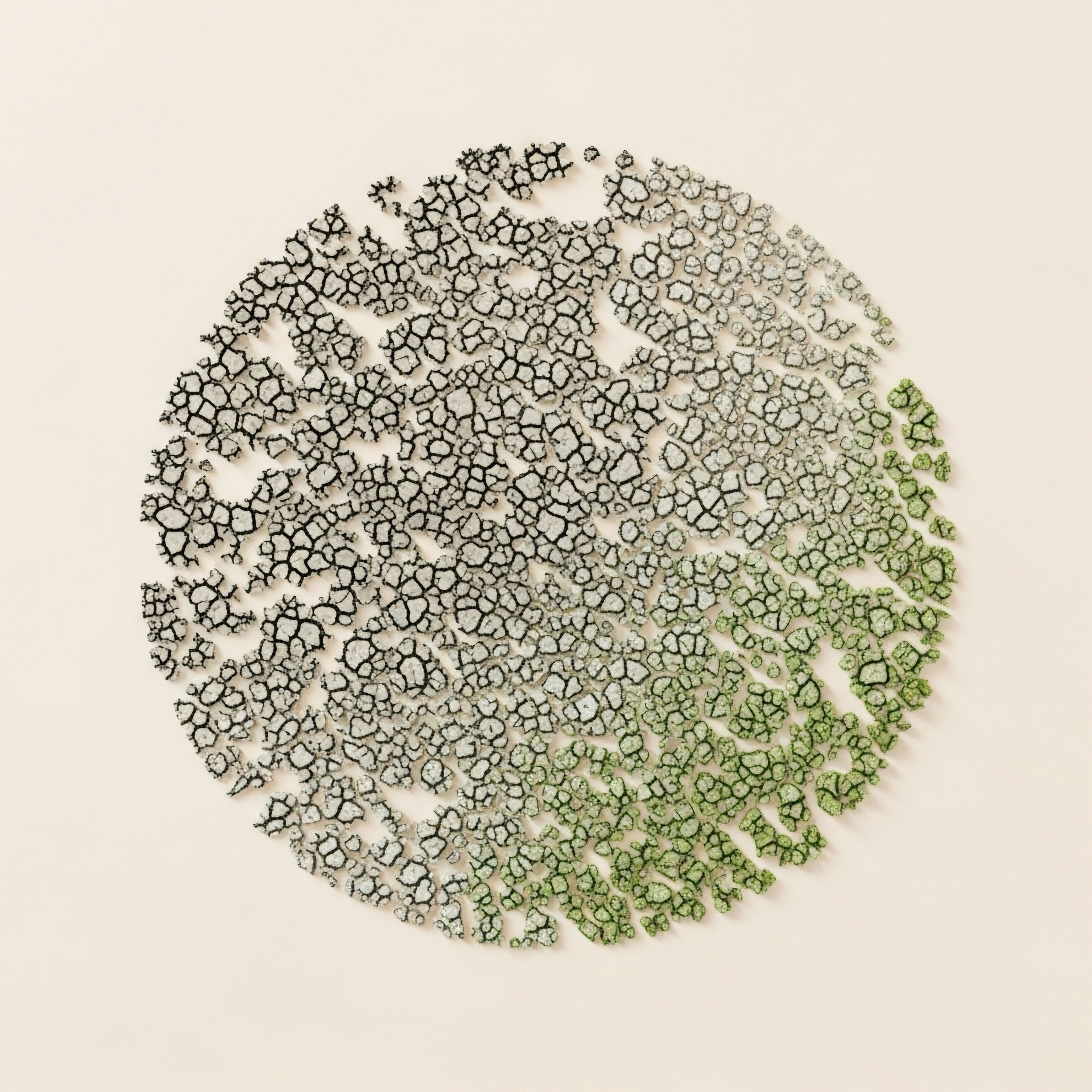

Fundamentals
Your experience of fatigue, mental fog, or a diminished sense of vitality is a valid and important starting point. These feelings are often the body’s method of signaling a deeper systemic imbalance. When we consider a testosterone protocol, we are looking at a tool for recalibrating a specific part of your endocrine system.
The efficacy of this tool, however, is profoundly connected to the environment in which it operates ∞ an environment shaped by your daily life. Your body’s hormonal network functions as an intricate, interconnected system, where each input has a cascading effect.
Think of your endocrine system as a finely tuned orchestra. Testosterone is a key instrument, yet its music is either amplified or muffled by the acoustics of the entire concert hall. These acoustics are your lifestyle choices. Nutrition, physical activity, sleep quality, and stress levels are not separate concerns; they are active participants in your hormonal health.
A protocol’s success is determined by how well these elements work in concert. For instance, chronic stress elevates cortisol, a hormone that can directly interfere with testosterone’s ability to perform its functions, creating a biological headwind against your therapeutic efforts.
A therapeutic protocol for testosterone is a powerful intervention, yet its ultimate success is governed by the biological environment you create through daily lifestyle choices.
The journey to hormonal optimization is a process of understanding and supporting your own unique biology. The introduction of exogenous testosterone is a significant step, but the work of optimizing its impact happens at the cellular level every day.
Your cells, specifically the androgen receptors that act as docking stations for testosterone, can become more or less sensitive based on these lifestyle inputs. This means that two individuals on the exact same protocol can have vastly different outcomes based on how their daily habits are conditioning their bodies to receive and utilize this vital hormone.

The Foundational Pillars of Hormonal Health
To truly support a testosterone protocol, we must look at the foundational pillars that govern your body’s internal chemistry. These are the non-negotiable elements that create a state of physiological receptivity, allowing the therapy to achieve its intended purpose. Without addressing them, you are asking the protocol to work against a current of biological resistance.

Nutrition as a Building Block
The foods you consume provide the raw materials for hormone production and function. A diet lacking in essential nutrients can undermine even the most precise therapeutic protocol. Specific nutrients are critical for the testosterone pathway.
- Zinc ∞ This mineral is directly involved in the production of testosterone. Oysters, lean meats, and legumes are excellent sources.
- Vitamin D ∞ Often called the “sunshine vitamin,” it functions more like a hormone in the body and is correlated with healthy testosterone levels.
- Healthy Fats ∞ Cholesterol, found in healthy fats like avocados and olive oil, is a precursor molecule for all steroid hormones, including testosterone.

The Role of Physical Activity
Exercise does more than build muscle; it sends powerful signals to your endocrine system. Resistance training, in particular, has been shown to increase the number and sensitivity of androgen receptors. This makes your cells more efficient at utilizing the testosterone available, whether it is produced naturally or introduced via therapy. Regular physical activity also helps manage weight, which is a critical factor in hormonal balance.


Intermediate
When you begin a testosterone optimization protocol, such as weekly injections of Testosterone Cypionate paired with Gonadorelin and Anastrozole, you are introducing a precise set of instructions into your biological system. The goal is to restore hormonal equilibrium and alleviate symptoms.
The degree to which your body follows these instructions is heavily modulated by systemic factors that you control. We can move beyond simple concepts of “healthy living” and examine the specific biochemical mechanisms through which lifestyle choices either synergize with or antagonize your therapy.
One of the most significant modulators is your metabolic health, particularly your body composition and insulin sensitivity. Adipose tissue, or body fat, is not an inert substance. It is a metabolically active organ that produces inflammatory cytokines and the enzyme aromatase. Aromatase converts testosterone into estrogen.
In a state of excess body fat, a significant portion of the testosterone from your therapy can be converted into estrogen, which can work against the goals of the protocol and introduce unwanted side effects. Therefore, maintaining a healthy body weight is a direct way to protect the integrity of your treatment.

The Interplay of Stress Sleep and Hormonal Cascades
The Hypothalamic-Pituitary-Adrenal (HPA) axis, your body’s central stress response system, has a profound and direct relationship with your Hypothalamic-Pituitary-Gonadal (HPG) axis, which governs testosterone production. Chronic stress leads to sustained high levels of cortisol. Cortisol and testosterone have a reciprocal relationship; when one is high, the other tends to be low.
This is an evolutionary mechanism designed to suppress non-essential functions like reproduction during times of crisis. In the context of TRT, high cortisol can dampen the body’s overall androgenic signaling, making the therapy less effective at the cellular level.
Chronic sleep deprivation functions as a significant physiological stressor, elevating cortisol and directly suppressing the body’s ability to produce and effectively utilize testosterone.
Sleep is the critical period when your body repairs itself and regulates its hormonal cascades. The majority of your natural testosterone production occurs during deep sleep. Insufficient or poor-quality sleep disrupts this process and also dysregulates the HPA axis, leading to higher cortisol levels during the day. This creates a state of hormonal resistance that your therapeutic protocol must overcome. A consistent sleep schedule of 7-9 hours per night is a powerful tool for enhancing the efficacy of your treatment.

Optimizing Androgen Receptor Sensitivity
The ultimate effect of testosterone therapy depends on the interaction between the hormone and its receptor at the cellular level. Androgen receptors (AR) are proteins within your cells that bind to testosterone, initiating a cascade of genetic expression that leads to effects like muscle growth and improved energy. The number and sensitivity of these receptors are not static. They can be upregulated or downregulated by lifestyle factors.
| Lifestyle Factor | Mechanism of Action | Impact on Testosterone Protocol |
|---|---|---|
| Resistance Training | Increases androgen receptor density in muscle tissue. Improves insulin sensitivity, reducing inflammation. | Enhances the anabolic and metabolic effects of testosterone. |
| High Body Fat | Increases aromatase enzyme activity, converting testosterone to estrogen. Produces inflammatory cytokines. | Reduces effective testosterone levels and can increase estrogenic side effects. |
| Poor Sleep | Disrupts the natural diurnal rhythm of testosterone release and increases cortisol. | Suppresses endogenous production and creates a catabolic hormonal environment. |
| Chronic Stress | Sustains high levels of cortisol, which directly antagonizes testosterone signaling. | Blunts the overall effectiveness of the therapy at a cellular level. |
By engaging in regular resistance training and maintaining a nutrient-dense diet, you can increase the population of androgen receptors in your tissues. This makes your body more receptive to the testosterone you are administering, leading to better clinical outcomes from the same dose. A diet rich in protein and micronutrients like zinc and vitamin D provides the necessary building blocks for these receptors.


Academic
The clinical efficacy of a given testosterone replacement protocol is determined by a complex interplay of pharmacokinetics and individual physiological variables. While standardized protocols provide a baseline for therapeutic intervention, the patient’s lifestyle introduces a layer of biological variability that can significantly alter outcomes.
A systems-biology perspective reveals that factors such as obesity, chronic low-grade inflammation, and insulin resistance create a biochemical environment that can profoundly attenuate the therapeutic signal of exogenous testosterone. This section will explore the molecular mechanisms through which these lifestyle-driven conditions modulate androgen signaling pathways.
Obesity, particularly visceral adiposity, is a primary confounding factor in testosterone therapy. Visceral adipose tissue functions as an endocrine organ, secreting a range of pro-inflammatory cytokines, including TNF-α and IL-6. These cytokines contribute to a state of systemic inflammation that has been shown to suppress the HPG axis at multiple levels, from hypothalamic GnRH release to testicular Leydig cell function.
Furthermore, these inflammatory mediators can directly interfere with intracellular signaling cascades downstream of the androgen receptor, potentially blunting the physiological response to testosterone binding.

The Adipose-Inflammation-Androgen Axis
The relationship between body fat, inflammation, and testosterone is bidirectional and self-perpetuating. Low testosterone promotes the accumulation of visceral fat, and visceral fat, in turn, suppresses testosterone through both aromatization and inflammation. When a patient with significant visceral adiposity begins TRT, the therapy is introduced into this pro-inflammatory, high-aromatase environment.
A substantial portion of the administered testosterone may be converted to estradiol, altering the testosterone-to-estrogen ratio and potentially leading to side effects like gynecomastia while failing to fully resolve hypogonadal symptoms.
The inflammatory state itself can also induce a form of androgen resistance. Chronic inflammation is associated with increased oxidative stress, which can damage cellular components, including the androgen receptor protein itself. Furthermore, inflammatory signaling pathways can phosphorylate coregulatory proteins that are essential for the transcriptional activity of the androgen receptor.
This means that even with adequate testosterone levels and receptor binding, the subsequent steps required to enact a genomic response may be inhibited. Therefore, lifestyle interventions that reduce inflammation, such as a diet rich in omega-3 fatty acids and regular exercise, are not merely supportive but are central to optimizing the molecular action of the therapy.

How Does Insulin Resistance Affect Bioavailability?
Insulin resistance, a common feature of obesity and a sedentary lifestyle, has a direct impact on the bioavailability of testosterone. One of the key mechanisms is its effect on Sex Hormone-Binding Globulin (SHBG). Insulin is a primary regulator of SHBG production in the liver; high levels of circulating insulin suppress SHBG synthesis.
While this might initially seem beneficial by increasing the proportion of free testosterone, the underlying metabolic dysfunction creates other problems. The low SHBG seen in insulin resistance is often a marker of a broader metabolic derangement that includes inflammation and increased aromatase activity, which ultimately work against the goals of therapy.
| Factor | Molecular Mechanism | Clinical Consequence |
|---|---|---|
| Visceral Adiposity | Upregulation of aromatase enzyme; secretion of inflammatory cytokines (TNF-α, IL-6). | Increased conversion of T to E2; systemic inflammation; potential androgen resistance. |
| Insulin Resistance | Suppression of hepatic SHBG production; increased systemic inflammation. | Lower total testosterone, altered bioavailability, and a pro-inflammatory state. |
| Resistance Exercise | Increased AR expression in skeletal muscle; improved insulin sensitivity; release of anti-inflammatory myokines. | Enhanced tissue-specific response to testosterone; reduced systemic inflammation. |
| Sleep Deprivation | Disruption of HPG axis pulsatility; increased cortisol and sympathetic nervous system tone. | Suppression of endogenous T production; creation of a catabolic state that opposes TRT’s anabolic goals. |
A comprehensive approach to testosterone therapy in a patient with lifestyle-related comorbidities must therefore include strategies to improve insulin sensitivity. This includes not only diet and exercise but also ensuring adequate sleep, as sleep deprivation is a potent inducer of insulin resistance. By improving insulin sensitivity, one can help normalize SHBG levels and, more importantly, reduce the background noise of systemic inflammation, allowing the signal of testosterone therapy to be heard more clearly at the cellular level.

References
- Traish, A. M. “Testosterone as a potential effective therapy in treatment of obesity in men with testosterone deficiency ∞ a review.” Current diabetes reviews vol. 10,2 (2014) ∞ 77-90.
- Shoskes, Daniel A. et al. “Pharmacology of testosterone replacement therapy preparations.” Translational Andrology and Urology vol. 5,6 (2016) ∞ 834.
- Vingren, J. L. et al. “Testosterone physiology in resistance exercise and training.” Sports Medicine vol. 40,12 (2010) ∞ 1037-1053.
- Cohen, P. G. “The role of testosterone in the treatment of obesity ∞ a review.” The journal of sexual medicine vol. 10,4 (2013) ∞ 907-916.
- Kelly, D. M. and T. H. Jones. “Testosterone ∞ a metabolic hormone in health and disease.” Journal of endocrinology vol. 217,3 (2013) ∞ R25-45.

Reflection
You have now seen how the inputs of your daily life are in constant dialogue with your internal chemistry. The information presented here is designed to move the conversation about hormonal health beyond a simple diagnosis and prescription. It positions you as an active, informed participant in your own wellness.
The science illuminates the path, showing how nutrition, movement, rest, and stress management are not adjunctive therapies but are central to the outcome. They are the very factors that determine how your body will receive and respond to the powerful tool of a testosterone protocol.

What Is Your Body’s Internal Environment?
Consider the state of your own internal environment. Is it one of calm and readiness, or one of stress and inflammation? Understanding the concepts of androgen receptor sensitivity and metabolic health provides a new lens through which to view your choices.
Each meal, each workout, and each night of sleep is an opportunity to improve the “acoustics” of your system, allowing the therapeutic signal of your protocol to resonate more clearly. The journey forward is one of continuous calibration, guided by how you feel and supported by the biological principles you now understand. Your path to vitality is uniquely your own, and this knowledge is the first step in navigating it with intention and confidence.



